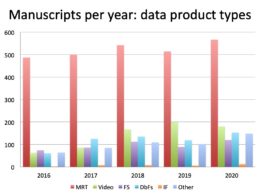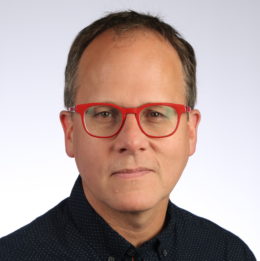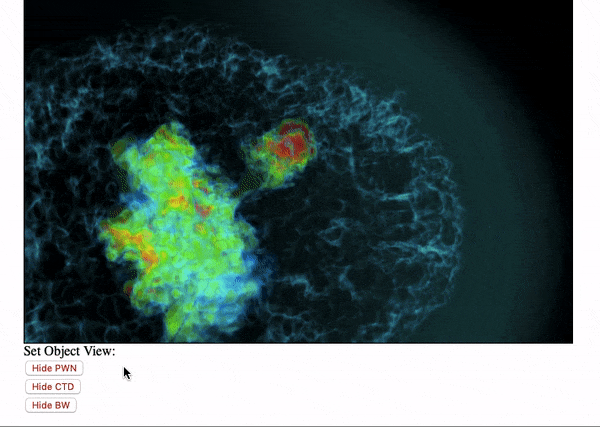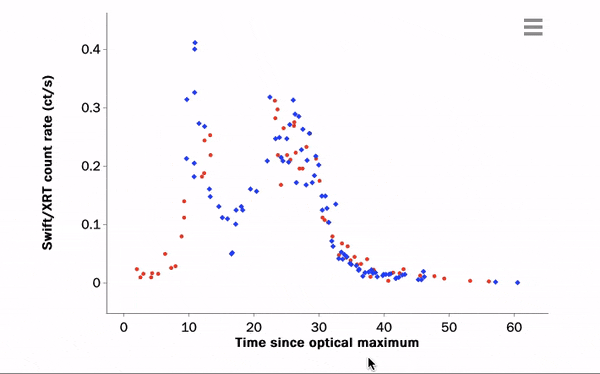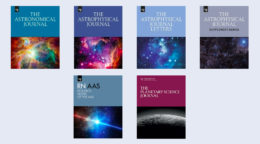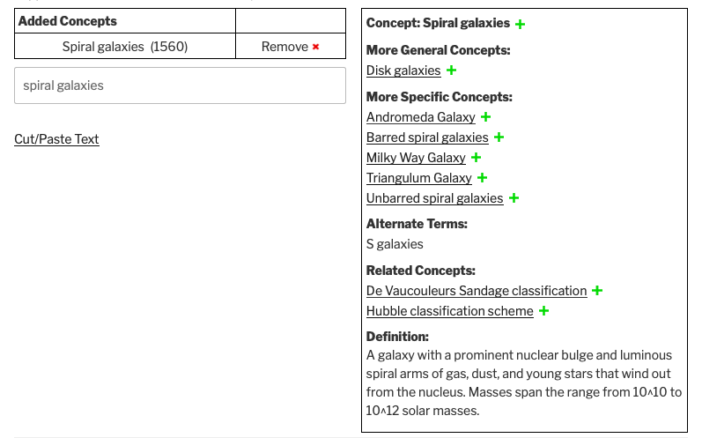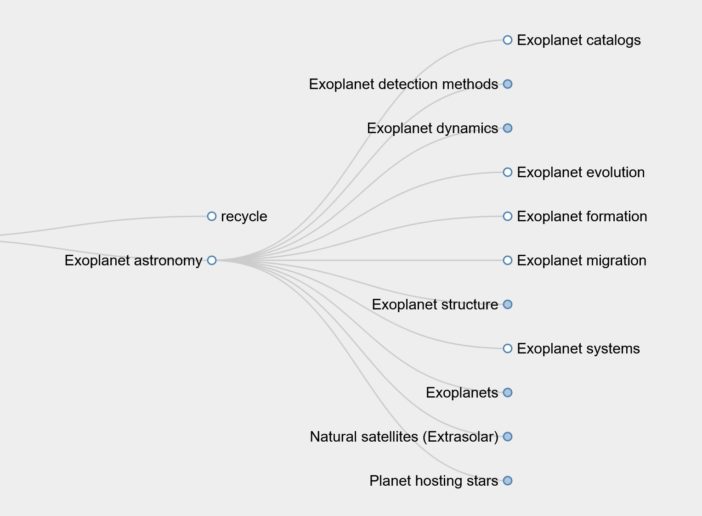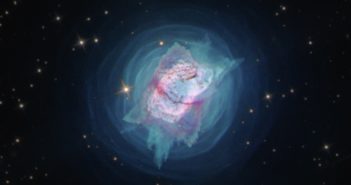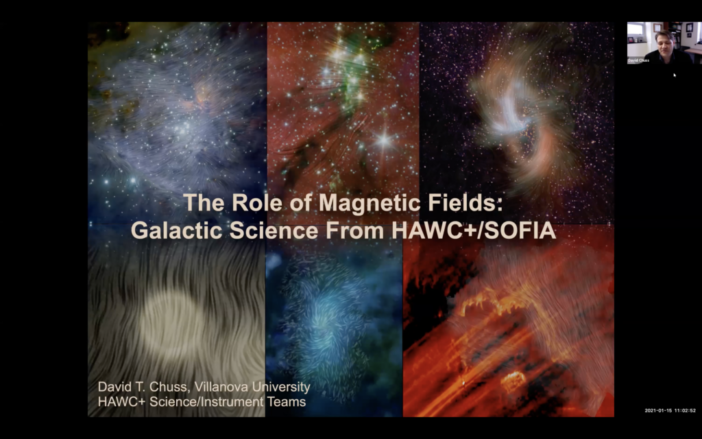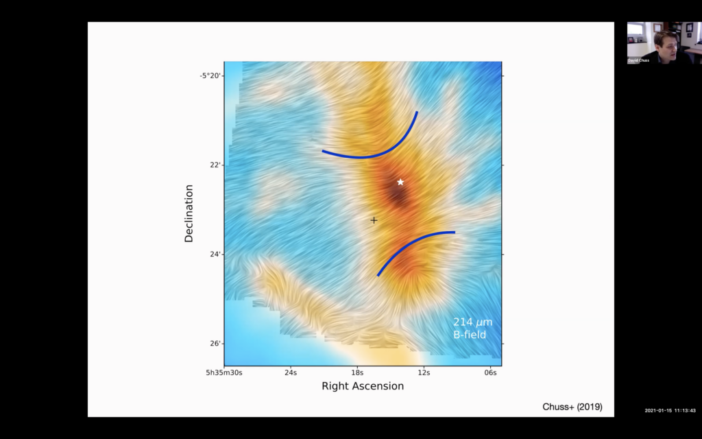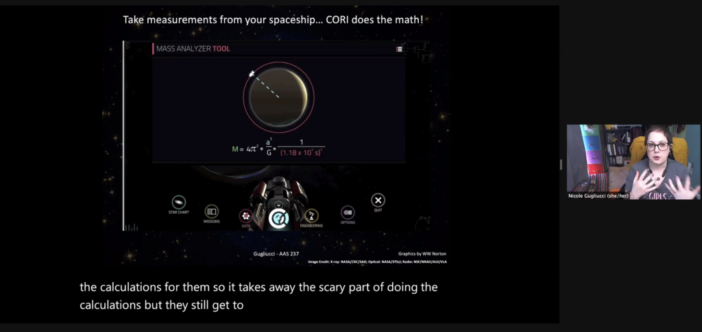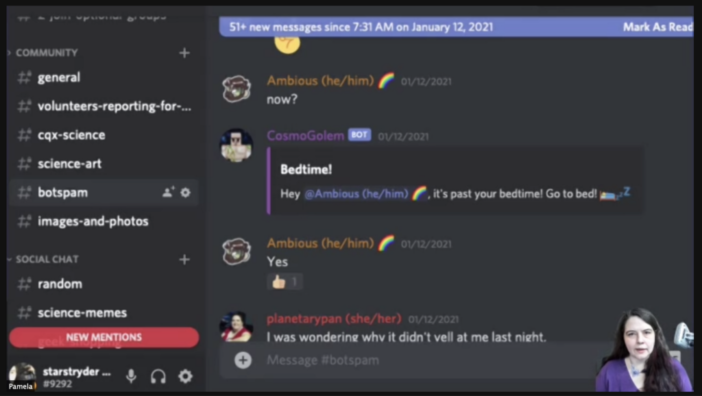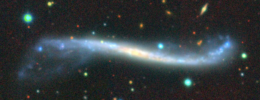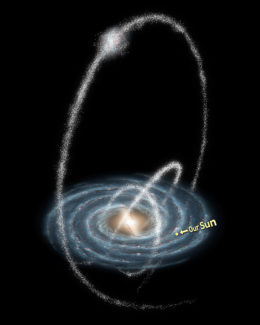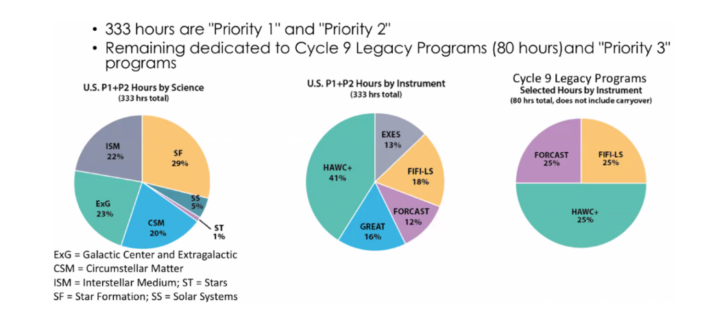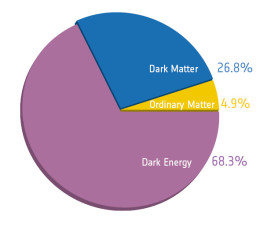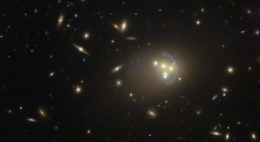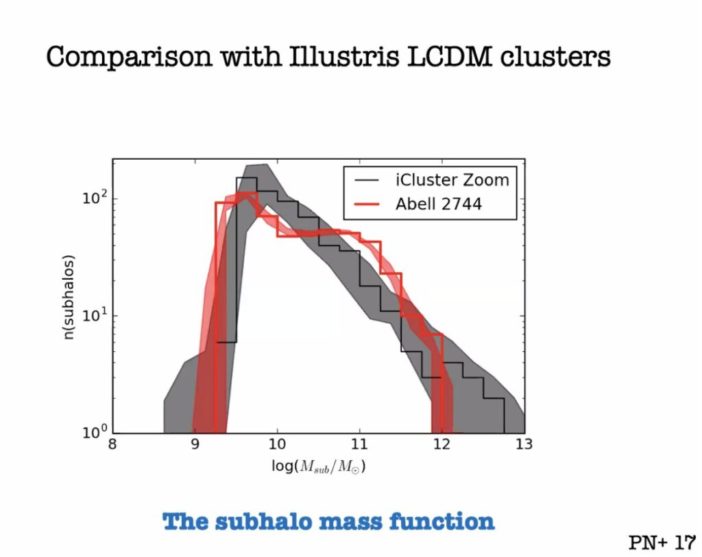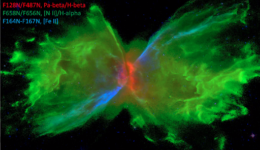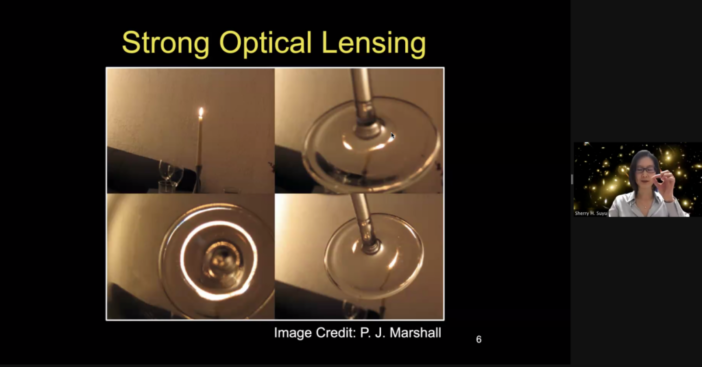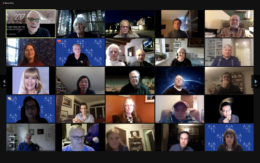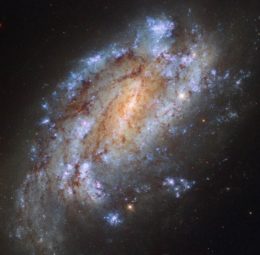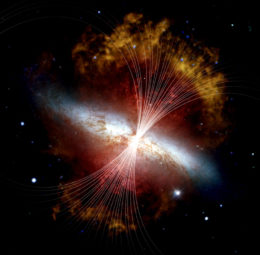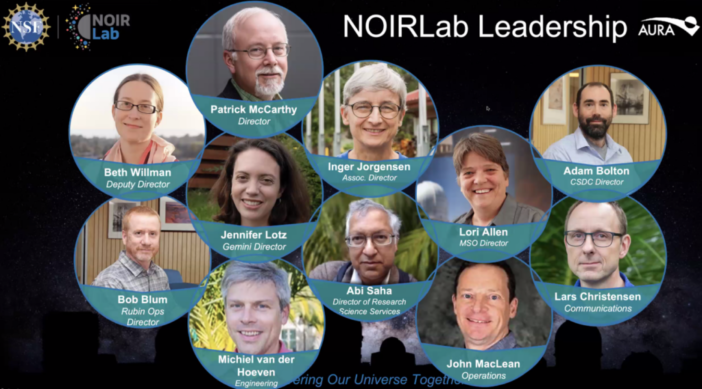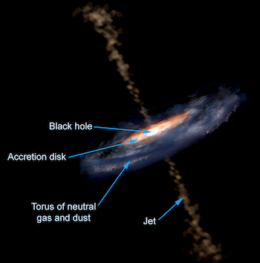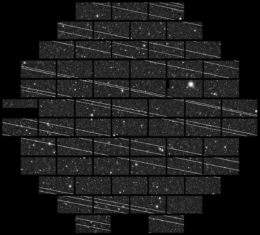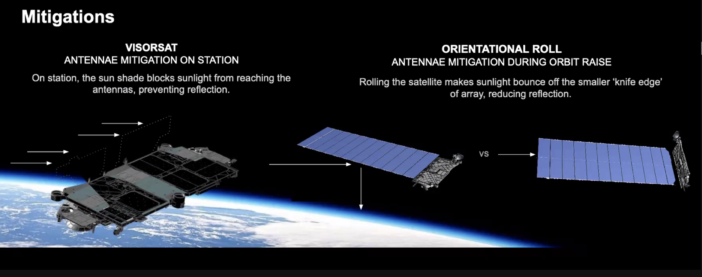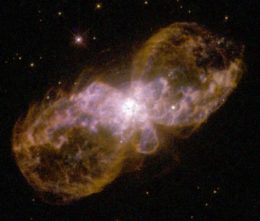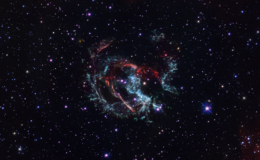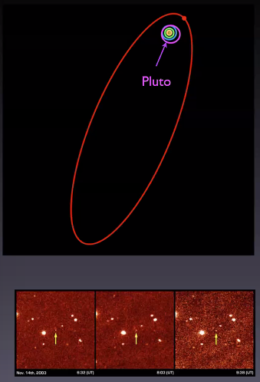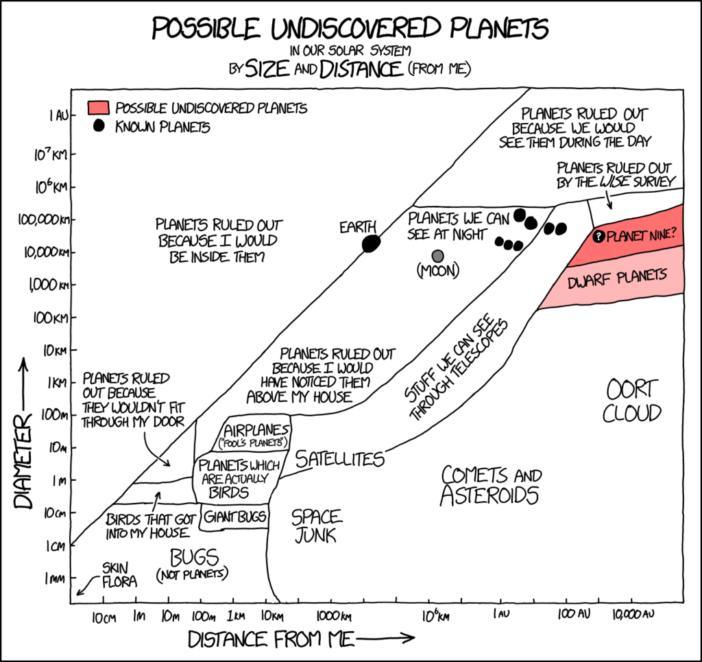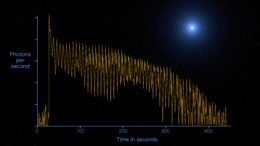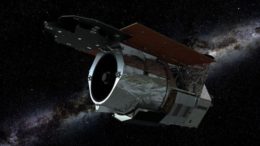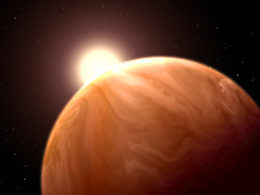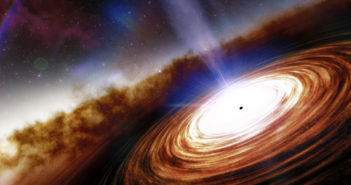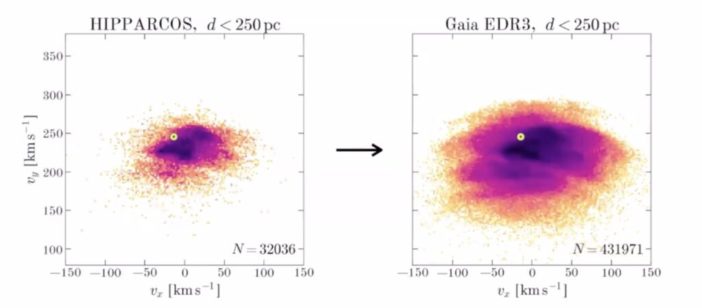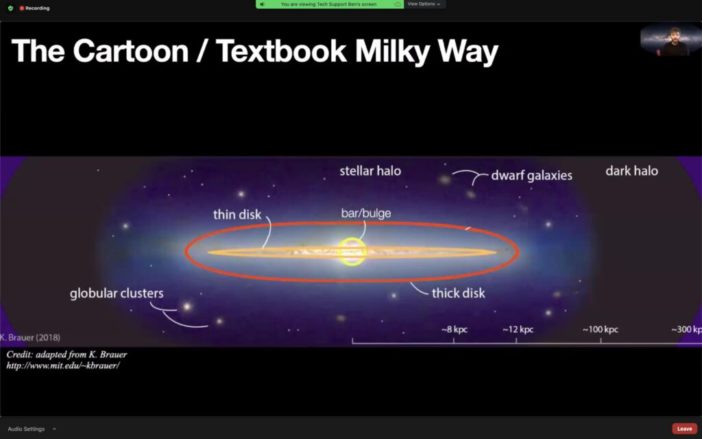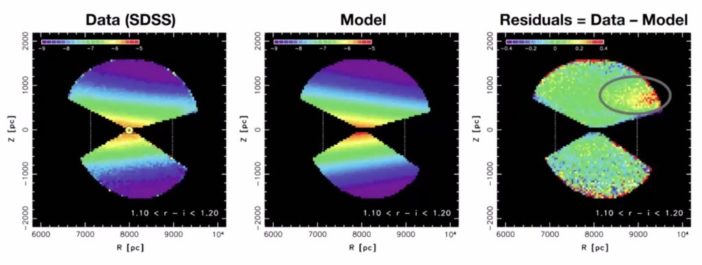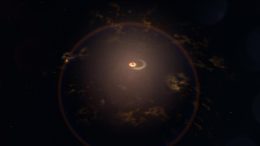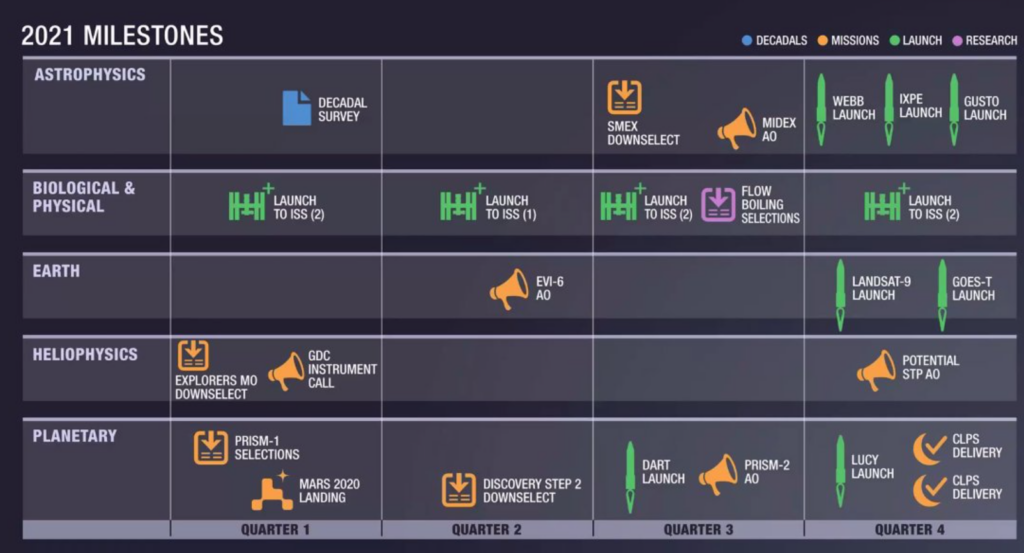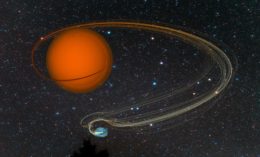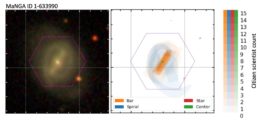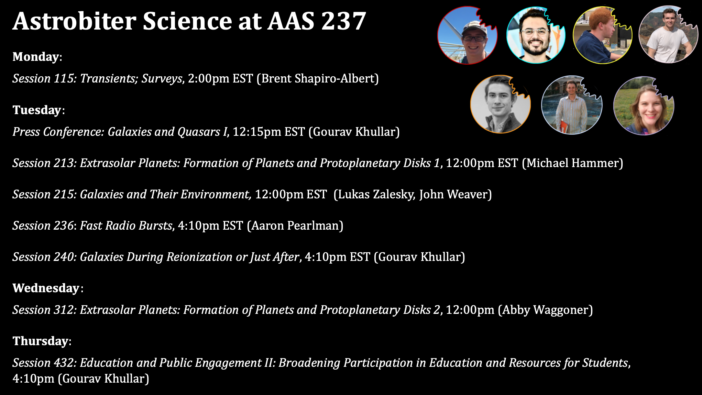Editor’s Note: This week we’re at the virtual 237th AAS Meeting. Along with a team of authors from Astrobites, we will be writing updates on selected events at the meeting and posting each day. Follow along here or at astrobites.com. The usual posting schedule for AAS Nova will resume on January 19th.
Welcome Address (by Abby Waggoner)
Welcome to AAS 237! This conference was initially going to be held in Arizona, but due to the COVID-19 pandemic, AAS 237 is being held virtually this week. Before we get into what’s going on this year, I thought it would be beneficial to take a moment to highlight some of the positive aspects of a virtual conference. Like AAS 236 (held in June 2020), attendance at AAS this year is at an all time high. So, even though we have to suffer through time zone differences and missing out on social aspects, the newest discoveries in astronomy are more accessible to astronomers (including students!) who otherwise might not have attended an in person conference because of a lack of time and/or funding.
This year about 3,000 people have registered for AAS, contributing seven plenary talks, 623 oral talks, 521 iPosters, 268 iPosters+, 11 town halls, 59 exhibitor booths, and 71 exhibitor webinars. A lot is happening this week. Luckily, Astrobites is here to sum up as much as we can in this blog and in live tweets (search #AAS237 as well)! We’ll be covering everything from plenary talks to career sessions, so stay tuned in the coming week.
While we’re hoping to “trash the pandemic in 2021,” as AAS President Paula Szkody stated, there are some big changes that are coming in the future. For example, how can we make a better virtual conference experience? If you have questions or recommendations, the AAS officers can be easily contacted, but it turns out there are many ways for students to become involved in AAS. First off, AAS officer elections are happening now, so if you’re a member, please go vote! Additionally, AAS members (including students!) can be involved in the Strategic Assembly, which meets every five years to determine the direction of AAS in the next five years, and members can also join a committee. While there are many committees, Paula highlighted three that have been important in the recent months: the Committee on Public Policy, the Ethics Committee, and the LPRS-LEOS.
Despite a global pandemic, we have found ways to connect and collaborate. Here’s to the beginning of an exciting week of science!
Live-tweeting of the session by Haley Wahl
Fred Kavli Plenary Lecture: The North American Nanohertz Observatory for Gravitational Waves (by Haley Wahl)
The conference was kicked off with a plenary by the National Radio Astronomy Observatory (NRAO) Dr. Paul Demorest. Dr. Demorest is part of the North American Nanohertz Observatory (NANOGrav) collaboration, a team of scientists spread throughout North America who are using pulsar timing to detect gravitational waves.
Dr. Demorest started off by introducing gravitational waves, which are ripples in the fabric of spacetime caused by the orbiting of large masses. Like sound waves, gravitational waves can have different frequencies, and that frequency is determined by what kind of object is emitting them (for example, the gravitational waves that LIGO detects are emitted by the mergers of neutron stars and stellar-mass black holes, whereas the gravitational waves that NANOGrav is sensitive to are emitted by objects like supermassive black hole binaries). NANOGrav uses pulsars, which are extremely dense, rapidly rotating neutron stars, to search for gravitational waves. Pulsars give off radio waves that cross our sightline like a lighthouse beacon. Millisecond pulsars (which are pulsars recycled in a binary system) have periods on the order of milliseconds, and they are extremely stable rotators, rivaling atomic clocks in terms of accuracy. Because they are so accurate, NANOGrav can model the exact time a pulse should arrive at our telescopes (called the “time of arrival”). As a gravitational wave comes toward us, it will push the spacetime in front of it and the pulsar will arrive slightly earlier than expected; if the gravitational wave is retreating, it will expand the spacetime between us and the pulsar, and the signal will arrive slightly later than expected.
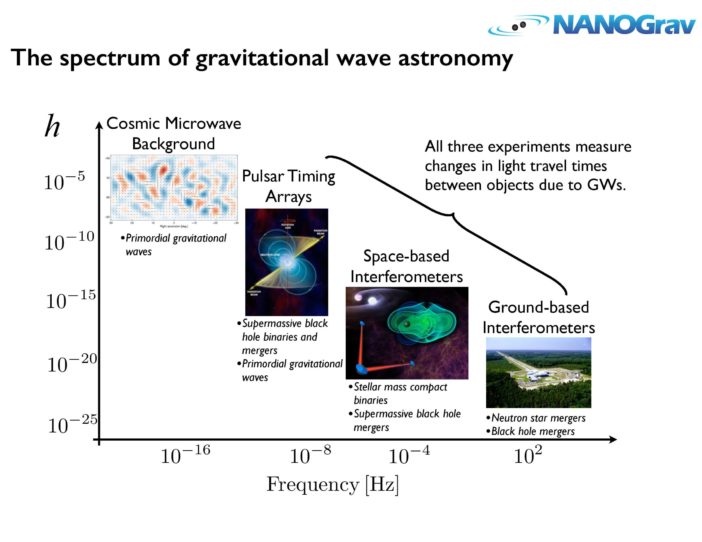
The gravitational wave spectrum and detectors. Here, frequency of the gravitational waves is plotted against strain (the fractional change in the separation between objects caused by the passage of the gravitational wave). [NANOGrav]
NANOGrav is currently observing 78 pulsars and adds ~4 pulsars to their array each year, and it observes each pulsar ~once a month. In NANOGrav’s latest data release (the 12.5-year release), the team finds significant evidence for low-frequency noise (a “common red process,” noise in the data set that is correlated in time; for more on the types of noise in the NANOGrav data sets, see Astrobites author Brent Sharpiro-Albert’s Twitter thread). Is this signal a detection of gravitational waves? The team isn’t sure. There is only very weak evidence for a Hellings-Downs (quadrupolar) angular correlation — it does not match up exactly with what they are expecting. How are they going to resolve this? With more data from recent, sensitive instruments like CHIME, MeerKAT, and FAST; upgrades to the Green Bank Telescope; and new pulsars. Beyond an initial detection, NANOGrav hopes to characterize the gravitational wave background, characterize properties of individual binaries and electromagnetic counterparts, and more! To learn more about NANOGrav’s latest data set, see Joe Simon’s talk at the press conference!
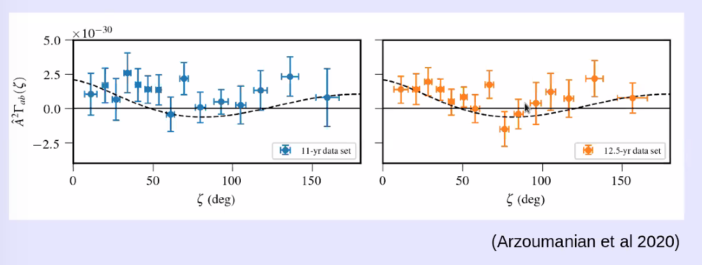
NANOGrav’s data plotted with the expected Hellings-Downs curve.
Live-tweeting of the session by Haley Wahl
CSMA Panel: A Discussion on Anti-Blackness in Astronomy (by Gourav Khullar)
This session, hosted by Dra. Nicole Cabrera Salazar and Prof. Lia Corrales (CSMA), was led and moderated by Ashley Walker (graduated from Chicago State University; applying to graduate schools), with a panel comprising junior Black astronomers and physicists Caprice Phillips (2nd year PhD student, Ohio State University, she/her), Erin Flowers (4th year PhD student, Princeton University, she/her), and David Zegeye (2nd year PhD student, The University of Chicago, he/him).
A host of topics were discussed in this session, ranging from what it meant for the panelists to be Black in the US, to how anti-Blackness manifested itself in predominantly white spaces. All panelists shared suggestions of what action-oriented allyship looks like, and they discussed their individual and collective visions for the future of both astronomy as a whole, and Black astronomy in particular. An astrobite with details of this extremely insightful discussion will follow the AAS meeting, later this month. In the meantime, you can find the Astrobites Twitter coverage of today’s session by Michael Hammer here. Also, check out our piece from summer 2020 on #BlackInAstro: How Can We Support Black Astronomers?
Press Conference: News from the Dark Side (by Susanna Kohler)
AAS 237’s press conference lineup kicked off with a discussion of a variety of things dark and hidden in our universe.
First up: a look at globular clusters, motivated by the past discoveries of mysterious dwarf galaxies that appear to be largely devoid of dark matter. Jessica Doppel, a graduate student at University of California, Riverside, discussed how adding globular clusters to the cosmological simulation Illustris allows us to better understand why some galaxies are missing dark matter. The simulations show that galaxies that host globular clusters with a low spread in velocities have often been stripped of a large fraction of their dark matter. This implies that ultradiffuse galaxies we’ve observed that have a very small spread in globular cluster velocities may have previously lost most of their dark matter.
What about dark matter closer to home? To understand the nature of dark matter in the Milky Way, we need precise measurements of the average acceleration of stars in our galaxy — tiny motions driven by the Milky Way’s dark matter and stellar mass. Sukanya Chakrabarti (Rochester Institute of Technology) presented work that uses the precise timing of pulsars as cosmic clocks to make the first direct measurements of our galactic acceleration. Determining these tiny changes in velocity provides valuable information that will help us to better understand the invisible forces that operate in our galaxy and beyond. Press release
Looking for more on NANOGrav’s latest news (see the summary of Paul Demorest’s plenary talk above)? The next presenter, Joseph Simon (University of Colorado, Boulder) provided us with a closer look at how NANOGrav works — namely, thanks to the incredible timing precision of the wide array of pulsars that “bob in an ocean of gravitational waves” — and then dug into the new, intriguing low-frequency signal that NANOGrav recently announced. This signal might correspond to a detection of the background ocean of gravitational waves, but it doesn’t quite match our expectations. So far, all we can say with certainty is that it’s a strong signal, a lot of sources of noise have already been ruled out, and we should have a better idea of what’s causing it with another couple years of data. It would be very exciting if we’ve actually found the gravitational-wave background after 12.5 years of searching with NANOGrav! Press release
Last up, Mattia di Mauro (National Institute for Nuclear Physics, Torino, Italy) rounded out the session on a different topic: the source of the unexpected excess of gamma-ray radiation spotted in the center of the Milky Way. Is this high-energy emission caused by dark matter particle interactions? Cosmic rays produced from the galactic center? Pulsars located in the galactic bulge? Di Mauro discussed the constraints that are imposed on the options by 11 years of Fermi-LAT data and state of the art models.
Live tweeting of the session by Haley Wahl
Historical Astronomy Division (HAD) Town Hall (by Luna Zagorac)
The Historical Astronomy Division (HAD) town hall started off with some regular division business. First up was a heartfelt congratulations to the winners of the September 2020 HAD elections, including Vice-Chair/Chair-Elect Terry Oswalt, as well as Amy Oliver and Samantha Thompson on the Executive committee. Next, the audience was reminded of HAD’s column in the AAS News Digest, “This Month in Astronomical History”, and that it is always recruiting new authors! If you have an idea or a pitch for the column, HAD would be delighted to hear from you, and you can contact them via the email listed for the column on their website. Furthermore, HAD dues are waived for junior, graduate, and emeritus members, making it easier for interested AAS members to join the Division without additional financial burden! One reason for becoming a member of HAD might be to turn in your nomination for the 2022 LeRoy E. Doggett Prize for Historical Astronomy, which any member of HAD can propose until March 1, 2021. Another might be to consider helping write obituaries for passed AAS members, which can be a thoughtful way to honor those that came before us, but also learn more about both their histories and science careers.

An image of the path of totality of the Total Solar Eclipse of 1870 over the island of Sicily, and a black and white photo of the Italian expedition to image the eclipse in Sicily, with Secchi circled. [Slide by Ileana Chinnici]
Live-tweeting of the session by Luna Zagorac
Plenary Talk: From Galaxies to Faces: Recognizing the Implications of Artificial Intelligence in Astronomy and Society (by Briley Lewis)
The second plenary of the conference went beyond presenting interesting science results, as Brian Nord (FermiLab) led us to critically think about how we’re “living with the tools we create.” It focused on how algorithms permeate our lives, as do the choices we make in implementation and development of those algorithms. Nord asks us to consider the following question: “Who gets to decide what knowledge and tools we pursue, and who is in the room when those decisions are made?” (Just a disclaimer: this short summary can in no way fully do justice to this incredible talk, and I highly recommend you watch the recorded version if you are able!)
Nord started out with a timeline of development, explaining the starts and stops of artificial intelligence (AI) over the past hundred or so years. He defines artificial intelligence as “a class of algorithms to build models primarily driven by data.” These algorithms “learn” by training with historical data. The algorithms are also shaped by our choices: how we design them, what network architectures we choose, and the data we use to train them. We’re in another wave of AI development now, which is set apart from the past attempts by our extremely large data sets, improvements in computing, and more efficient algorithms.

An example of classification in astronomical data from Nord’s talk.
Two critical challenges AI faces are bias and uncertainty. Because our training sets are historical, they cannot necessarily predict the future, and they are often limited in size and diversity, leading to bias. Uncertainty is also a main technological challenge in AI development, since there is currently a lack of reliable methods for error propagation. Despite these challenges, AI shows great promise as a powerful tool for astronomy. It has already been used for multiple scientific challenges: classification of strong lenses, image disentangling for CMB polarization and E modes, simulations that are sped up by GANs (generative adversarial networks), and self-driving telescopes. Classification is a particular strong suit for AI, which Nord describes as “almost a hands-down win because of how it accelerates looking through a large data set.” Astronomical experiments are getting too complex to design and develop in a timely manner using traditional methods, Nord claims, but they can be sped up with AI.

An example of AI generated art in Nord’s talk. Panel A is the figure that was generated by AI.
Before diving headfirst into the pool of artificial intelligence, though, Nord reminds us to think about “what our role will be in this evolution” and to ask, “Maybe we can, but should we?” The allure of AI is strong: it can tell us what to watch, what to buy, how to distribute medicine more efficiently, possible solutions for climate change, how to make travel safer with self-driving cars, and it can even make art and play games now. But we mustn’t neglect the perils that come with this promise.
Using surveillance as a case study for the dark side of AI, Nord lists many examples of ethically questionable uses of these algorithms: Google collecting email data to sell ads, Amazon keeping microphones on in its smart devices, and Clearview AI selling a facial recognition neural net trained by social media data to law enforcement. These algorithms use biased training sets in order to predict emotions, gender, race, ethnicity, and more, all with implications for who gets healthcare, who gets into college, who goes to jail, and maybe even who dies in combat.
Nord calls on us all to acknowledge our responsibility as scientists and citizens, saying that “we care about measurements and biases in our dark matter measurements, so why not biases in those who are incarcerated.” We need to consider whose dreams our communities value and who is in the room when knowledge is created and questions are asked. He explains how white supremacy permeates our spaces, including our research communities, and that fact is not divisive — division ensues from how we choose to respond to that fact. We should care about diversity in our communities, not because it supposedly increases our productivity, but because it is just. We bear responsibility for the things we create.
Given these heavy facts and the impending boom of AI, what can we do to ensure that these algorithms are used equitably and justly? Nord suggests reading about the ethical and social implications of our work, learning from scholars in critical race theory, ethics, social science, and beyond. We need to call out science that hurts people when we see it, and advocate for reform, such as banning biased facial recognition in law enforcement. We can also participate in and support organizations based on these principles, such as the Algorithmic Justice League, the AI Now Institute, FAT/ML, and the Alphabet Workers Union.
As scientists, we must remember that we are funded by the people that these algorithms impact, and we have the ability to change the way we collaborate, centering first and foremost the question of “is our community healthy?” like he and collaborators have in the Deep Skies Lab. We have an opportunity to reimagine our role in the future of science and AI, and it’s time we reconsider whose voices we are raising up.
Interview of Brian Nord by Mia de los Reyes
Live-tweeting of the session by Michael Hammer
Press Conference: Exoplanets & Brown Dwarfs (by Ellis Avallone)
The second press conference of the meeting was all about stellar companions, primarily exoplanets. First, Dr. David Ciardi (Caltech) talked about the decade-long confirmation of Kepler’s second planet candidate. KOI-5 was detected in the first 10 days of the Kepler mission, via a pristine transit lightcurve. With such a nice transit detection, why did KOI-5 take so long to confirm? The answer: it’s in a triple-star system. Initial follow-up observations with the Keck telescope on Maunakea revealed a secondary companion. When Dr. Ciardi and his group attempted to characterize KOI-5 with radial-velocity (RV) observations, they found that these signals were dominated by the stellar companions. With the sheer number of planet candidates Kepler was detecting, it isn’t surprising that KOI-5 got pushed to the back burner. A decade later, KOI-5 was observed with TESS, which brought Dr. Ciardi back to this elusive planet. The observation of a transit with TESS, along with new RV observations, gave Dr. Ciardi enough information to solve for the secondary star’s orbit. Subtracting this information from the RV signal revealed the RV signal of the planet — a 57 Earth mass object. We also learned from this second look at KOI-5 that the orbits of the planet and the multi-star system are misaligned. This once-forgotten planet may yet reveal more interesting information about how planets in multi-star systems form and evolve. Press release

Artist’s rendering of a 10-million-year-old star system with a gas-giant planet like Jupiter. [NASA/JPL-Caltech/T. Pyle]
Moving on, Dr. Lauren Weiss, a postdoc at the University of Hawai`i at Mānoa, took a turn to talk about rocky planets, specifically TOI-561b. TOI-561b is a 3-Earth-mass planet originally detected with TESS and confirmed using RV observations from Keck. Follow-up observations revealed that this planet’s host star is located in the thick disk of our Milky Way, indicating that this star is around 10 billion years old! This finding suggests that TOI-561b is the oldest exoplanet we’ve found, which shows that rocky planets have been forming for far longer than originally thought. Additionally, thick disk stars are much more metal poor than the host stars of other rocky planets, which raises questions surrounding the stellar properties required for rocky planet hosts. In the context of astrobiology, Dr. Weiss speculates that these old rocky planets may serve as our best chance for finding intelligent life outside our solar system. Press release

Illustration of the planet-hunting telescope Kepler. [NASA/Ames Research Center/W. Stenzel/D. Rutter]
Live-tweeting of the session by Ellis Avallone
Helen B. Warner Prize: Hidden Friends to Gravitational Wave Sources at the Hearts of Galaxies (by Michael Hammer)
This year, the AAS awarded the Helen B. Warner Prize to Professor Smadar Naoz (Univ. of California, Los Angeles) for “her many early career contributions to theoretical astrophysics.” Naoz, who was also the 2015 Annie Jump Cannon Prize recipient at AAS 227, has worked on a wide variety of topics including the “formation of the first stars” and the “unexpected orbital properties of hot Jupiters”, but she decided to focus today’s talk solely on black hole mergers and related sources of gravitational waves. Black hole mergers have been in the spotlight in astronomy ever since LIGO made the first ever detection of gravitational waves back in 2015! Since then, LIGO and Virgo combined have made 50+ detections of several different types of mergers. With this abundance of detections, it may be easy to forget that until a few years ago, we had no idea how many black hole mergers to expect. In fact, theoretical models had shown that under ordinary conditions, individual black hole pairs would take longer than the age of the universe to merge. If ordinary mergers are indeed that slow, then what are the sources of LIGO’s and Virgo’s gravitational wave detections?
That’s where Naoz came to the rescue. With her research group, she sought to calculate the rates of mergers in conditions that aren’t ordinary, focusing on black hole pairs “at the heart of galaxies.” This is an extreme location because of (1) the much higher number density of stars, and (2) the nearby supermassive black hole (SMBH) at each center. The heart of a galaxy is even more extreme if the SMBH has a >40° inclination between its plane and the orbital plane of a nearby black hole pair. In this case, the SMBH has the power to drastically alter the orbit of the black hole pair, turning it from near-circular to highly eccentric and back again! This repeating cycle is called the Kozai-Lidov mechanism. Naoz in particular developed the eccentric Kozai-Lidov (EKL) mechanism, which applies to more realistic cases where both black holes in the pair have mass and their orbit isn’t perfectly circular. Unlike the regular Kozai-Lidov mechanism, the eccentric Kozai-Lidov mechanism can excite the black hole pair to extremely high eccentricities of e > 0.99 so that one approaches the other, just like a comet approaches the Sun. With such a high eccentricity, these black holes are much more prone to collide on timescales even as low as a few hundred years, much faster than the age of the universe!
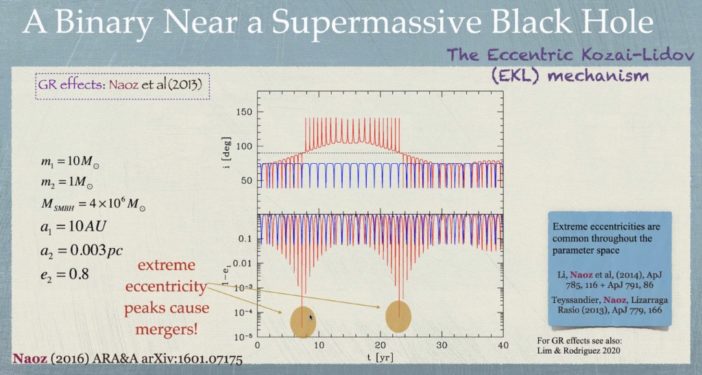
Inclination (top) and eccentricity (bottom) evolution of a black hole pair near a SMBH inclined at >40 degrees. While the Kozai-Lidov mechanism (blue) only excites black hole pairs to e = 0.9, the eccentric Kozai-Lidov mechanism (red) can excites black hole pairs to e > 0.9999. Such extreme eccentricities lead the black holes to merge, creating gravitational waves!
Now that Naoz had a way for black holes to merge quickly, she wanted to know how many black hole pairs there were to begin with, to predict how many gravitational wave events LIGO can detect per year. Naoz and her group explored the rates at which binary star systems in the galactic center can form pairs of black hole pairs and other compact objects that produce gravitational waves. They found that most binary stars won’t produce black hole pairs or other gravitational wave sources because binaries are prone to becoming unbound and separating when other stars pass by. Even though outcomes that produce gravitational waves are less likely, Naoz and collaborators still find enough gravitational wave sources to predict that LIGO should be able to detect a few dozen events per year!
Throughout the talk, Naoz emphasized the contributions of her students to this work and highlighted current and recent grad students Sanaea Rose, Alexander Stephan, and Bao-Minh Haong in particular, as well as undergraduate Cheryl Wang.
Interview of Smadar Naoz by Briley Lewis
Live-tweeting of the session by Briley Lewis
Career Session: Public Speaking in a Virtual Environment (by Abby Waggoner)
Do you get the jitters just before giving a presentation? Do your hands clam up at the thought of talking in front of your colleagues? Does the idea of a virtual presentation make your hair stand on end? If you answered yes to any of these questions, you are like nearly every other human on this planet. This discussion-based session, led by Alaina G. Levine (Quantum Success Solutions), covered some important bullet points to consider when giving a presentation and how to calm your nerves. The main takeaways are listed below, but there was one common sentiment that Alaina emphasized again and again.
“There is value in what you have to say.”
“You are the expert, and you have the capability to be a good speaker.”
“You have something of value to share, and your audience knows it. Your audience wants you to succeed.”
“There is a reason you have been given that platform.”
As the zoom chat filled with stories of presentation grief, Alaina repeated these phrases at every point during the discussion. The key takeaway from this session is this: fortify your confidence when giving a talk. Every time we speak, in our everyday conversations, in group meetings, and at conferences, our words hold value. Remember that what you have to say matters.
Other recommendations included:
- Fortify your confidence.
- Connect with your audience.
- Place sticky notes on your monitor, reminding you to look into the camera, not the screen. This allows the audience to feel more connected.
- Remember to smile.
- Keep a clean and neat space behind you.
- Have lighting that frames your face.
- Present your information as a story. Your audience won’t remember a figure or table, but they’ll remember a story and how it made them feel.
- Tell your audience. Tell them again. Then summarize what you already told them.
- If someone is interrupting you (such as an unmuted listener), interrupt yourself to ask that person to stop being an interruption.
- Know the main points, but don’t write your speech word for word.
- Ask yourself why your presentation is of interest to your audience.
- Own your mistakes. They will happen. You appear more confident when you recover and can continue after making a mistake.
- Move your body! Alaina kept her hands in the camera shot to maintain non verbal communication typically lost over zoom.
- Add dramatic pauses.
- Increase and decrease your volume to emphasize points.
- Pre-recorded talks: record them once, so you don’t record them again and again and again.
- Repeat questions out loud.
- You aren’t expected to know everything. Your job is to communicate the knowledge that you have, so it’s okay to not know the answer to a question.
- Remember: “You are the expert, and you have the capability to be a good speaker.”
- Remember: “There is value in what you have to say.”
Career Session: Combat Impostor Syndrome (by Abby Waggoner)
Whether you’ve realized it or not, you’ve likely felt impostor syndrome at some point in your life. Impostor syndrome is the internal doubt that many of us feel when surrounded by accomplished peers, the nervous feeling at applying for an internship or grant we don’t know if we can get, and the overall feeling of being a fraud. Almost everyone has experienced imposter syndrome, as the cartoon below shows.
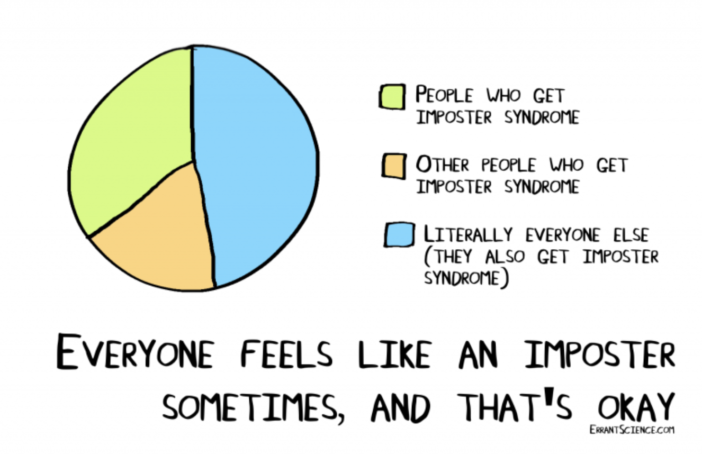
Everyone struggles with impostor syndrome sometimes. [errantscience.com]
If you find doubt clouding your accomplishments and self worth, I highly recommend utilizing the resources in this summary. We all feel this way at some point, like when we’re applying for grad school, switching fields of research, in group meetings, and at conferences. But make sure to remind yourself of everything you have accomplished to be where you are and where you are going. In the words of Alaina, the most important thing you can do is “honor yourself and everything that you do.”



